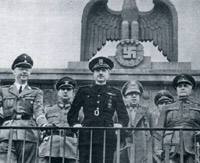
The uniform press
- Madrid, 1938. That the Spanish Civil War had not yet ended, but II. When the Republic had only one last breath left, the Francoists developed and passed the press law that would be in force from 1939 to 1966. This law was just another part of a larger program: It was necessary to correct the course of Spanish history from the 17th century onwards.

Franco himself told Juan Borbón in a letter: “The evils of Spain do not come after April 14; the process of decomposition has deeper roots. When we talk about monarchy, we refer to the Catholic Monarchs or Philip II.arenaz. Later times are those of the bad school, of the decadent monarchy without a pulse, of the monarchy that, instead of reflecting the genius of Spain abroad, accepts and exalts anti-Spain.” But the shootings and arrests to avoid this wrong path were not enough. The maximum benefit from repressive techniques had to be obtained and for that purpose they had to be included in schools and newspapers. In the midst of the flourishing of totalitarianism, the Francoists received the experience of the Nazis and Fascists to finally pass a law more harsh than that of Italy or Germany. The Spanish text, for example, contained prior censorship, and both Hitler and Mussolini decided to reject this possibility.
In the new regime the journalist had to be an “apostle of the nation’s thought,” a “bearer of faith.” A mandatory document for journalism was established – the one with the number 1 was given to Franco. Half of the publications across Spain disappeared and in several places the loss was even more serious: There were 26 newspapers in Barcelona at the time of the war, and after the law came into force, only six remained. Of the 4,000 journalists who requested to continue their work in 1939, only 1,800 obtained permission. All this, as far as the Spanish press is concerned. The new law left no room for manuscripts in Catalan or Basque. For example, the Light of Heaven was not published after 1936, and despite the attempts in the 1950s, it would not resume its activity until 1963.
However, for some, the law was not hard enough in some places, and extreme proposals were extended. The most striking thing is what Minister Ramón Serrano Suñer did: he wanted journalists to wear uniforms. He designed the prototype and everything. But the proposal was eventually rejected. Perhaps because in the newsrooms there were enough uniforms in those days: bastanas, falangistas, roquetas... Probably because it was enough to standardize the criteria and contents of the journalists.
In the new regime the journalist had to be an “apostle of the nation’s thought,” a “bearer of faith.” A mandatory document for journalism was established – the one with the number 1 was given to Franco. Half of the publications across Spain disappeared and in several places the loss was even more serious: There were 26 newspapers in Barcelona at the time of the war, and after the law came into force, only six remained. Of the 4,000 journalists who requested to continue their work in 1939, only 1,800 obtained permission. All this, as far as the Spanish press is concerned. The new law left no room for manuscripts in Catalan or Basque. For example, the Light of Heaven was not published after 1936, and despite the attempts in the 1950s, it would not resume its activity until 1963.
However, for some, the law was not hard enough in some places, and extreme proposals were extended. The most striking thing is what Minister Ramón Serrano Suñer did: he wanted journalists to wear uniforms. He designed the prototype and everything. But the proposal was eventually rejected. Perhaps because in the newsrooms there were enough uniforms in those days: bastanas, falangistas, roquetas... Probably because it was enough to standardize the criteria and contents of the journalists.